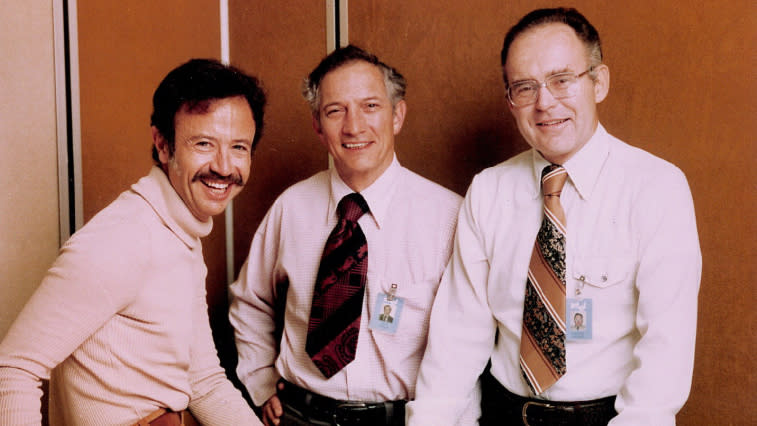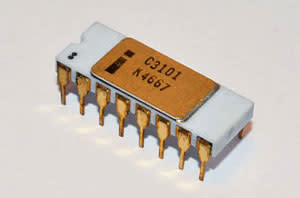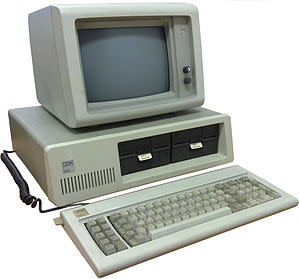Intel turns 50: How the chip behemoth got its start

“CBS Sunday Morning” aired my report on Intel’s 50th anniversary on Sunday, July 22 (you can watch it here). We had more material from my interviews than we had time to broadcast. So, here’s a look at some of the behind-the-scenes tales we couldn’t fit on TV.
In 1968—if you do the math, that’s 50 years ago—computers were as big as rooms. They were comparatively slow and consumed massive amounts of power.
At the company he’d co-founded, Fairchild Semiconductor, engineer Bob Noyce had co-invented a different approach: integrated electronics, where the circuitry was printed, or etched, onto tiny slices of the element silicon.
At that time, integrated electronics cost many times more than the existing technology (small, can-shaped transistors plugged into a circuit board). But they were much smaller and easier to manufacture. Noyce and his buddy Gordon Moore figured that the price would come down—and that silicon chips were the future.
And so, 50 years ago today, they quit Fairchild and started a new company. It became one of the giants of the modern world, defining the PC era, helping give Silicon Valley its name, and becoming a technological and marketing colossus.
You may know the name of the company they founded that day: NM Electronics.
The first chip
By the end of the month, of course, they adopted a better name, short for integrated electronics: Intel.
Noyce and Moore’s original plan was to produce memory chips. Intel’s first product debuted nine months later: The 3101 memory chip, the world’s first solid-state RAM chip.
But by 1971, Intel had introduced its first microprocessor—a chip to process data, not just store it—which eventually became Intel’s bread and butter, and the enabler for the entire world of electronics we know today.


“In 1969, a Japanese calculator company called Nippon [Calculating Machine Corporation] contacted Intel,” says Elizabeth Jones, Intel’s archivist and museum curator. “They wanted Intel to create for them a series of chips that could run their adding machines. Intel took the job. We ended up producing four chips for them, one of them being the 4004.
“In hindsight, they realized that the 4004, programmed differently, could run different things than just an adding machine,” Jones says.
“Intel went back to Nippon and requested the design rights to the chip. And Nippon said, ‘We don’t really need the design rights. We’ll sell you back the design rights for the investment we made in the design—$60,000.’ Intel repurchased the design rights and were able to then start marketing this as a true general purpose microprocessor. And that was in 1971.”
The culture
John Doerr is the chairman of Kleiner Perkins, one of the world’s most successful venture capital firms. He began his career working at Intel—and he’s been a keen observer ever since.
“In the summer of ’74, I came to Silicon Valley with no job, no place to live, $50 in my pocket,” he says. “My girlfriend had dumped me, so I was looking for her. I was pretty persistent—she rightly wanted to avoid me.
“I cold-called my way into the highest-ranking Intel executive I could get on the phone, Dr. Bill Davidow. And they interviewed me, and I got a job writing benchmarks to show that Intel’s microprocessors were superior to the ones from Motorola. To my delight, right down the hall from where my summer job was, was my girlfriend! When I showed up there, she was not amused at all. But over the course of the summer, we put the relationship back together again, and we’ve now been married for 40 years.”
According to everyone I spoke to, Intel’s success owes a lot to its corporate culture, as set by Noyce, Moore, and their third employee, Andy Grove (whom they also hired away from Fairchild).
“One of the important lessons I took away from Intel was the importance of culture and values,” Doerr says. “Andy Grove and the other Intel leaders concluded that Intel’s culture was one of aggressive introverts, engineers who wanted to systemically solve problems by having an environment that wasn’t hierarchical, but where the best ideas could all get put on the table and the best idea would win.
“So a very apolitical environment, one that is rigorous, ruthlessly intellectually honest, and of course very competitive. And I think that’s true of Intel then, it’s true of Intel today. It’s certainly been regarded by many—me included—one of the, if not the, best managed technology company in the world.”
“Intel has a very egalitarian culture,” adds historian Jones. “No one has an office with a door, everyone is in cubicles—even the CEO. No reserved parking spots.”
“You know, Andy Grove grabbed me once,” Doerr says. “And he said something I’ll remember forever. He said, ‘John, it almost doesn’t matter what you know. What matters is results. Ideas are easy, it’s execution that’s everything.’ That’s become a mantra of mine: ideas are easy, execution’s everything.”
The IBM moment
Shifting the company from a memory maker to a processor maker was “a wrenching transition,” Doerr says.
In 1980, an unidentified customer for Intel’s processors, based in Boca Raton, Fla., agreed to use a version of Intel’s 16-bit microprocessor called the 8088. That customer turned out to be IBM. The 8088 was to be the brains of its new machine for consumers, the PC.


“And then Bill Gates wrote an operating system for it, and thus began what’s called the Wintel Monopoly, if you will, as most of the PCs and most of the PC software was written to take advantage of that very high-volume platform,” Doerr says.
And if IBM chosen some other company’s chip that day?
“Intel probably wouldn’t be here today.”
The CEOs
In Intel’s 50 years, it has had six CEOs. Three of them were the company’s founders, Noyce, Moore (of the famous Moore’s Law), and Andy Grove.
“Somehow, Intel’s CEOs have alternated hot and cool personalities,” Doerr says. “So Bob Noyce was very emotive and outgoing and smooth, and Gordon was very quiet, almost introverted, introspective. Andy Grove was a fiery, hot personality. Craig Barrett, more cerebral; he ran manufacturing.
“Paul Otellini was a broad-based leader, but effusive and a guy who could put together a deal with Steve Jobs that Andy Grove could never could. And then Brian Krzanich, who rose through the ranks as a manufacturing leader is a very—again, kind of on cool personality. And interestingly, all of these grown from within. They never recruited from outside the company.”
Slipups
Intel’s record of execution has been impressive—how many tech companies are still thriving after 50 years?—but not flawless. It has had to weather the occasional technical embarrassment, like the Pentium bug in 1994 or the Spectre and Meltdown vulnerabilities earlier this year.
More seriously, Intel mostly missed the smartphone wave. “It’s fairly well-documented that along the way, we missed the CPU or the modem that’s inside the phone,” interim CEO Bob Swan told me. “That being said, we adjusted, adapted, and got into powering PCs, tablets, phones, data centers, cars, et cetera. So we are a player of supplying modems and technologies into phones today.”
As the world moved away from PCs, the company’s bread and butter, into mobile devices, the company lost its position as the world’s biggest chip maker (it’s now in second place, after Samsung), and had to lay off thousands of workers in 2009, 2014, and 2016.
On the other hand, Intel has made up much of the difference by supplying the processors for the world’s data centers—better known as the Cloud.
The Next 50
Today, Intel is investing heavily into self-driving cars and AI technologies. The goal is to carry on Noyce and Moore’s vision for another 50 years, and beyond.
“The makeup of the company started with the founders,” says CEO Swan. “And [Bob Noyce] said these simple words back 50 years ago: ‘Don’t be encumbered by the past. Go and do something wonderful.’ And those simple words from our founders…I kinda see every day in this company.”
—
David Pogue, tech columnist for Yahoo Finance, welcomes comments below. On the Web, he’s davidpogue.com. On Twitter, he’s @pogue. On email, he’s [email protected]. You can sign up to get his stuff by email, here.
More by David Pogue:
